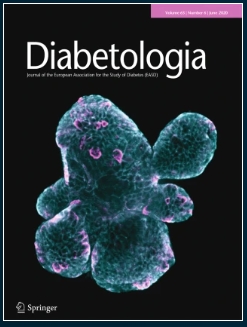Frequent longitudinal blood microsampling and proteome monitoring identify disease markers and enable timely intervention in a mouse model of type 1 diabetes.
IF 10.2
1区 医学
Q1 ENDOCRINOLOGY & METABOLISM
引用次数: 0
Abstract
AIMS/HYPOTHESIS Type 1 diabetes manifests after irreversible beta cell damage, highlighting the crucial need for markers of the presymptomatic phase to enable early and effective interventions. Current efforts to identify molecular markers of disease-triggering events lack resolution and convenience. Analysing frequently self-collected dried blood spots (DBS) could enable the detection of early disease-predictive markers and facilitate tailored interventions. Here, we present a novel strategy for monitoring transient molecular changes induced by environmental triggers that enable timely disease interception. METHODS Whole blood (10 μl) was sampled regularly (every 1-5 days) from adult NOD mice infected with Coxsackievirus B3 (CVB3) or treated with vehicle alone. Blood samples (5 μl) were dried on filter discs. DBS samples were analysed by proximity extension assay. Generalised additive models were used to assess linear and non-linear relationships between protein levels and the number of days post infection (p.i.). A multi-layer perceptron (MLP) classifier was developed to predict infection status. CVB3-infected SOCS-1-transgenic (tg) mice were treated with immune- or non-immune sera on days 2 and 3 p.i., followed by monitoring of diabetes development. RESULTS Frequent blood sampling and longitudinal measurement of the blood proteome revealed transient molecular changes in virus-infected animals that would have been missed with less frequent sampling. The MLP classifier predicted infection status after day 2 p.i. with over 90% accuracy. Treatment with immune sera on day 2 p.i. prevented diabetes development in all (100%) of CVB3-infected SOCS-1-tg NOD mice while five out of eight (62.5%) of the CVB3-infected controls treated with non-immune sera developed diabetes. CONCLUSIONS/INTERPRETATION Our study demonstrates the utility of frequently collected DBS samples to monitor dynamic proteome changes induced by an environmental trigger during the presymptomatic phase of type 1 diabetes. This approach enables disease interception and can be translated into human initiatives, offering a new method for early detection and intervention in type 1 diabetes. DATA AND CODE AVAILABILITY Additional data available at https://doi.org/10.17044/scilifelab.27368322 . Additional visualisations are presented in the Shiny app interface https://mouse-dbs-profiling.serve.scilifelab.se/ .在1型糖尿病小鼠模型中,频繁的纵向血液微采样和蛋白质组监测可识别疾病标志物,并使及时干预成为可能。
1型糖尿病在不可逆的β细胞损伤后表现出来,强调了对症状前阶段标志物的关键需求,以实现早期和有效的干预。目前识别疾病触发事件的分子标记的努力缺乏分辨率和便利性。分析经常自行采集的干血斑(DBS)可以发现早期疾病预测标志物,并促进量身定制的干预措施。在这里,我们提出了一种新的策略来监测由环境触发引起的瞬时分子变化,从而能够及时拦截疾病。方法对感染柯萨奇B3病毒(CVB3)的成年NOD小鼠,定期(每1 ~ 5 d)抽取全血(10 μl)或单独用媒介物处理。血样(5 μl)在滤片上干燥。DBS样品采用邻近延伸法进行分析。使用广义加性模型来评估蛋白质水平与感染后天数(p.i.)之间的线性和非线性关系。提出了一种多层感知器(MLP)分类器来预测感染状态。在第2天和第3天分别用免疫或非免疫血清治疗cvb3感染的socs -1转基因(tg)小鼠,然后监测糖尿病的发展情况。结果频繁的血液采样和血液蛋白质组的纵向测量揭示了病毒感染动物的短暂分子变化,这些变化在不频繁的采样中可能会被遗漏。MLP分类器在第2天预测感染状态,准确率超过90%。在第2天用免疫血清治疗后,所有(100%)cvb3感染的SOCS-1-tg NOD小鼠都能预防糖尿病的发展,而用非免疫血清治疗的8只cvb3感染的对照组中有5只(62.5%)发生了糖尿病。结论/解释:我们的研究证明了频繁采集DBS样本对监测1型糖尿病症状前阶段由环境触发引起的动态蛋白质组变化的效用。这种方法可以实现疾病拦截,并可以转化为人类的举措,为1型糖尿病的早期发现和干预提供了一种新的方法。数据和代码可用性额外的数据可在https://doi.org/10.17044/scilifelab.27368322。额外的可视化呈现在Shiny应用程序界面https://mouse-dbs-profiling.serve.scilifelab.se/中。
本文章由计算机程序翻译,如有差异,请以英文原文为准。
求助全文
约1分钟内获得全文
求助全文
来源期刊

Diabetologia
医学-内分泌学与代谢
CiteScore
18.10
自引率
2.40%
发文量
193
审稿时长
1 months
期刊介绍:
Diabetologia, the authoritative journal dedicated to diabetes research, holds high visibility through society membership, libraries, and social media. As the official journal of the European Association for the Study of Diabetes, it is ranked in the top quartile of the 2019 JCR Impact Factors in the Endocrinology & Metabolism category. The journal boasts dedicated and expert editorial teams committed to supporting authors throughout the peer review process.
 求助内容:
求助内容: 应助结果提醒方式:
应助结果提醒方式:


